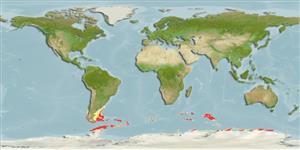Environment: milieu / climate zone / depth range / distribution range
Écologie
marin démersal; profondeur 100 - 1115 m (Ref. 5192). Temperate; 37°S - 67°S
Southern Ocean, South Atlantic, and South Indian Ocean. Argentine shelf/slope from 37°S to the Falklands and Burdwood Bank. Also Kotlyar; Crozet Islands and Prince Edward Island (Ref. 5000). Recorded from Chile (Ref. 27363).
Taille / Poids / Âge
Maturity: Lm ? range ? - ? cm
Max length : 50.0 cm SL mâle / non sexé; (Ref. 11892)
Description synthétique
Clés d'identification | Morphologie | Morphométrie
Épines dorsales (Total) : 0; Rayons mous dorsaux (Total) : 112 - 129; Épines anales: 0; Rayons mous anaux: 91 - 104. Pelvic fin on ocular side (with 7 soft rays) extremely larger than on blind side (with 5 soft rays). Caudal fin rounded (Ref. 27363).
Inhabit the lower continental shelves with surface-dwelling larvae and juveniles (Ref. 11892).
Life cycle and mating behavior
Maturities | Reproduction | Spawnings | Egg(s) | Fecundities | Larves
Heemstra, P.C., 1990. Achiropsettidae. p. 408-413. In O. Gon and P.C. Heemstra (eds.) Fishes of the Southern Ocean. J.L.B. Smith Institute of Ichthyology, Grahamstown, South Africa. (Ref. 5000)
Statut dans la liste rouge de l'IUCN (Ref. 130435)
Menace pour l'homme
Harmless
Utilisations par l'homme
Pêcheries: commercial
Outils
Articles particuliers
Télécharger en XML
Sources Internet
Estimates based on models
Preferred temperature (Ref.
123201): 1.4 - 5.8, mean 3.3 °C (based on 139 cells).
Phylogenetic diversity index (Ref.
82804): PD
50 = 1.0625 [Uniqueness, from 0.5 = low to 2.0 = high].
Bayesian length-weight: a=0.01995 (0.00906 - 0.04395), b=3.01 (2.83 - 3.19), in cm total length, based on all LWR estimates for this body shape (Ref.
93245).
Niveau trophique (Ref.
69278): 3.7 ±0.54 se; based on food items.
Résilience (Ref.
120179): Milieu, temps minimum de doublement de population : 1,4 à 4,4 années (tm=2-3).
Fishing Vulnerability (Ref.
59153): Moderate vulnerability (44 of 100).
Climate Vulnerability (Ref.
125649): High to very high vulnerability (74 of 100).
Nutrients (Ref.
124155): Calcium = 35.3 [15.1, 57.1] mg/100g; Iron = 0.311 [0.153, 0.570] mg/100g; Protein = 18.7 [15.3, 22.4] %; Omega3 = 0.426 [0.222, 0.835] g/100g; Selenium = 23.4 [12.0, 48.1] μg/100g; VitaminA = 7.78 [1.84, 35.15] μg/100g; Zinc = 0.39 [0.27, 0.57] mg/100g (wet weight); based on
nutrient studies.
